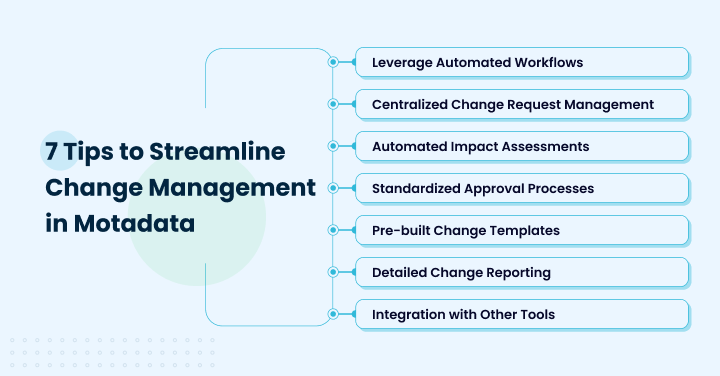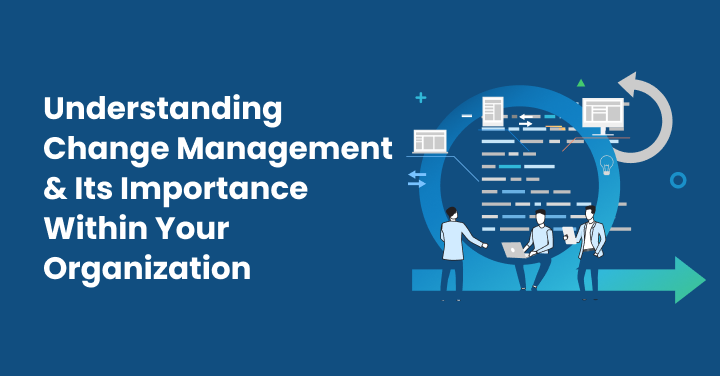Customer expectations and business tactics often take a new turn with the difference in demands.
Depending on the requirements and upcoming technologies, change management becomes important.
In fact, over the past few years, digital transformation has been the key contributor to business success and change in dynamics.
It has improved IT management by eliminating problematic areas and making businesses capable of facing challenges.
Change management directs organizational switches from beginning to end and ensures it is executed successfully.
It involves adding, modifying, and removing anything (levels or processes) that might affect your service in the future.
The modification is vital in terms of technology and if you are making organizational shifts.
Handling these constant switches can be a bit complex, but with the right tools like Motadata, you can achieve success.
It is an advanced IT infrastructure management platform that comes with enhanced change management features.
It can help streamline efforts, improve efficiency, and achieve desired outcomes.
However, change implementation might come with a few challenges.
Let us understand more about the change management tool and tips to simplify its implementations.
Understanding Motadata’s Change Management
Motadata’s change management process was designed to help IT teams streamline the shift in implementations and better manage and monitor IT operations.
The powerful ITIL Change Management Tool provides a structured approach to handling all changes and modifications effectively.
It offers full control and enables users to monitor the modulation through multiple stages from a single tool.
With this technology, organizations can monitor and handle change requests, evaluate their impacts, expedite approval procedures, and increase the effectiveness of change management overall.
With this tool, the managers in charge can track and address these challenges faster, whether they involve approval delays, risk management, or coordination issues.
Further, the process-driven automation feature helps businesses ensure that modifications are implemented systematically and transparently, reducing the chances of interruptions and improving IT service quality.
Another advantage of investing in this tool is it offers transparency with variation in information.
You can track differences at various organizational levels and dedicate stages for schedule.
You can even run an audit trail to keep track of changes and modifications.
With more transparency, businesses can make better decisions and minimize risks.
Business leaders can view people’s work histories and create requests using pre-built templates.
This robust change management tool offers more features that can help your organization simplify complex tasks and reduce potential risks and their impact on performance.
7 Tips for Simplifying Change Implementations with Motadata
1. Leverage Automated Workflows:
Automation is one of the key features of the popular Motadata change management module.
By leveraging automated workflows, an organization can ensure timely implementation of changes and increase operational efficiency.
They eliminate manual tasks, reducing the risk of human errors.
Team members will no longer have to spend extra time and effort on sending change requests, updating documentation, and alerting stakeholders, as everything will be automated.
Further, it facilitates collaboration among stakeholders throughout the change management process.
These procedures guide change requests through predetermined steps, ensuring that all required approvals and reviews are completed before proceeding.
Automated workflows help streamline processes, offer transparency to change requests, and enhance efficiency.
In short, organizations that utilize automated workflows may increase operational efficiency, guarantee timely and successful change implementations, and streamline their change management process.
2. Centralized Change Request Management:
While using Motadata to streamline change implementations, one more crucial point to consider is the centralization of change request management.
By centralizing the management of change requests, organizations may efficiently track and manage change requests, ensuring that changes are appropriately documented, evaluated, and approved.
The centralized platforms offer clear visibility into change requests and allow users and stakeholders to track and access all the data they require from a single console.
Further, they ensure that all changes are documented carefully, facilitating compliance with regulatory standards.
Additionally, centralized management enhances team collaboration, as each member can access the latest and up-to-date information from a single source.
In short, centralized change management software guarantees the successful implementation of change efforts.
Read Also: Understanding Change Management and Its Importance Within Your Organization
3. Automated Impact Assessments:
It is essential to understand the potential impact a change request can have before making final decisions.
Automated impact assessments are a key feature in Motadata’s tool, which helps organizations identify potential risks related to changes beforehand, prioritize change types, and make informed decisions.
For example, if a change can have a positive impact on performance and operations, you can prioritize such changes based on the assessment report and ensure efficient resource relocation.
Further, it allows users to identify potential risks and dependencies at an initial stage, thus reducing the chances of disruptions.
You can even use automated impact assessments to evaluate the effects of several changes, including organizational, process, and technical changes.
This aids businesses in planning change implementations by helping them comprehend the possible effects of each change type.
4. Standardized Approval Processes:
Using consistent approval procedures is essential to making implementations of Motadata change easier.
Organizations can improve transparency, efficiency, and consistency by standardizing approval processes, guaranteeing that change requests are evaluated and granted by predetermined criteria.
By following an efficient approach to reviewing change requests and approvals, organizations can reduce delays, improve collaboration, and enhance efficiency.
This approach speeds up the whole process and helps ensure that changes align with the project goals.
Additionally, it guarantees that all relevant parties participate in the decision-making process, improving the quality and reliability of the modifications being carried out.
5. Pre-built Change Templates:
Another key feature offered by the Motadata module is a pre-built change template that helps simplify change implementations.
You can modify these templates to meet certain organizational requirements; they are created using industry best practices.
They provide a structured approach to managing changes and foster continuous improvement.
Further, organizations can save time using these templates and better plan and track all the modifications.
This enables enterprises to create an efficient and successful change program, increasing the success rate of projects.
Instead of starting from scratch for every change request, organizations may utilize a template that already has all the procedures and factors to consider.
Further, these templates support managing risks, identifying stakeholders, recording requirements, and monitoring the advancement of change projects.
6. Detailed Change Reporting:
Comprehensive reporting enables organizations to track their key performance indicators (KPIs) and measure the success and impact of their modifications.
Detailed reporting is crucial for continuous improvement and compliance.
With Motadata’s reporting capabilities, organizations can track data modulation history and approvals and assess financial results.
These insightful reports help identify improvement areas, track progress and impact, and enable better decision-making.
For example, they may indicate that a particular sort of change is prone to problems, which may lead to reviewing and modifying the pertinent procedures.
Further, organizations can gain insights into the effectiveness of change projects and evaluate the success rate and consequences.
Comprehensive change reporting helps organizations evaluate the financial outcomes of change initiatives.
This involves assessing the financial gains from successful change initiatives, such as return on investment and cost reductions.
Additionally, extensive reporting aids in demonstrating compliance with regulatory obligations since companies can clearly illustrate their change management plan efforts and results.
7. Integration with Other Tools:
Motadata’s seamless integration with other IT management solutions allows for a comprehensive understanding of changes and their effects on the IT infrastructure.
Through integration, organizations can coordinate change management initiatives with their overarching change management strategy, guaranteeing that change projects align with the company’s objectives and strategic priorities.
Further, entire teams, departments, and functions within a business can all handle change with greater proficiency.
Configuration management databases (CMDBs), service desks, and monitoring systems are a few tools you may integrate well to enable better decision-making.
Integrating these tools allows users to gain more visibility into the systems and changes.
For example, one way to ensure accurate impact assessments and planning is to integrate with a CMDB, which enables real-time updates on asset status and dependencies.
Conclusion
Change is inevitable; all you can do to stand out is adopt an approach that enables you to better manage your changes and modifications.
Implementing enhanced change management in Motadata will not only help streamline all your processes at the organization level but also boost efficiency and prepare you for the future state.
By using the above-listed practices, you can lead to successful change management.
Make sure to analyze the current state, take necessary steps, and work in alignment with the project objectives.
With automated workflows, you can reduce manual operations and identify potential impacts of change initiatives.
Further, the centralized change request management allows business leaders and project managers to monitor and manage changes from a central location.
With clear visibility, they can adapt different ways to manage several changes.
The automated impact assessment is another feature that helps track bottlenecks and potential risks beforehand.
Standardized Approval Processes allow users to review and approve each change to help reduce delays and guarantee deep evaluation of change requests based on predetermined criteria.
The Motadata tool even comes with pre-built change templates that help save time and improve success rates.
Thanks to this new product, the IT team no longer has to start from scratch for every change request.
It even comes with comprehensive reporting and integration support that helps improve overall efficiency and enable businesses to manage the variations more proficiently.
These pointers offer an organized approach to smoothly handling data modifications in your company, which will enhance operational efficiency and lower risks.
By adopting these techniques, you can handle the switches with assurance and accuracy.
FAQs
Using Motadata’s change management features can be highly advantageous for any organization, for it helps successfully navigate change and achieve goals. Here are a few more benefits of using this tool for your organization, including:
- It offers a centralized platform to track, manage, monitor, review, and submit change requests, thus enhancing visibility and improving team collaboration and communication.
- The organizational change management model’s automated impact assessment feature helps identify and mitigate risks at an early stage.
- Standardized approval processes guarantee consistency in assessments and minimize bottlenecks.
- Saves time and ensures consistency with pre-built change templates
- Comprehensive reporting provides insights for ongoing compliance and improvement.
- Integrates well with existing IT management tools for better view and impact assessments.
Motadata’s automated processes simplify implementing change by reducing human resources, reducing human errors, and increasing operational effectiveness. The feature guides change requests through predefined stages and manage all the tasks related to approvals and reviews on time. It further offers transparency throughout the entire process.
Further, when an action is needed from stakeholders, automated notifications notify them, cutting down on delays and enhancing collaboration. It enables organizations to optimize resources and better manage change projects.
Yes, Motadata integrates well with many IT management tools and monitoring systems. Whether you want it to integrate with service desk solutions or configuration management databases (CMDBs), it offers seamless integration.
This further helps team members generate a more comprehensive approach for managing the variations and ensures all data can be managed from a single place, thus offering more visibility and better decision-making.








